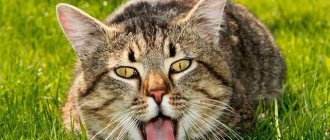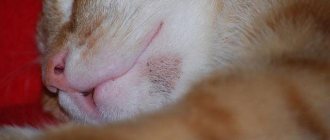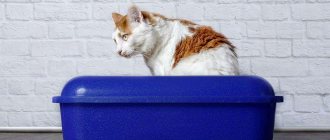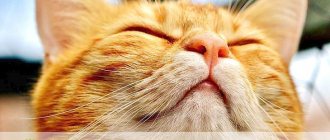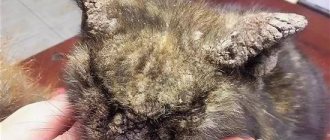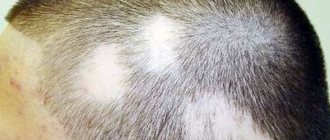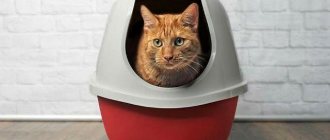Vomiting in a cat is most often a protective reaction of the body, with the help of which the animal rids the stomach of mechanical impurities. This is a natural physiological process that does not require human intervention. But if the cat starts vomiting white foam, then this is an alarming sign.
The cause of the appearance of foam in vomit can be both physiological and pathological factors, including dangerous viral infections. Let's find out how to help your pet at home before the veterinarian arrives.
Why does a cat vomit white foam?
The causes of white foam vomiting in a cat can vary. Normally, an animal regurgitates during a long period of absence of food. In this way, the pet gets rid of excess gastric juice, which irritates the mucous membrane and can cause inflammation and the formation of ulcerative areas.
Physiological causes of white foam vomiting in a cat also include:
- accumulation of hair in the stomach;
- accidental ingestion of foreign bodies that can be found in vomit;
- eating plant stems (cats swallow them to cleanse their stomachs of fur);
- severe stress or prolonged stay in a state of nervous tension;
- sexual hunting;
- compression of the abdominal organs by the growing uterus during pregnancy;
- toxicosis during pregnancy;
- motion sickness in transport;
- taking certain medications.
Important! To help your cat get rid of hair in its stomach, it should be fed grass with tough stems (wheatgrass). The hairs stick to them easily and firmly, and then come out when the cat regurgitates them along with saliva.
Causes of vomiting in kittens
When a kitten is breastfed, the cause of vomiting may be the cat's consumption of poor-quality food, medications, or medications.
Usually, when this factor is eliminated, vomiting stops. But if, after weaning from its mother at the age of 1-2 months, the kitten begins vomiting white foam, then this may be due to the following reasons:
- abrupt transfer from breastfeeding to commercial feed or natural products;
- overeating or swallowing large pieces of food;
- swallowing large amounts of fur hairs when licking;
- ingestion of inedible objects.
These factors in most cases do not pose a threat to life. They are easily corrected by changing the diet and increased attention to the care of animals.
But owners should know that 2 months is a dangerous age for kittens. At this time, the immune cells obtained from mother's milk cease to cope with maintaining resistance, and babies have not yet formed their own immunity.
This allows infectious agents to easily enter the body and cause dangerous diseases.
Often the first sign of the development of pathology at 2 months is the kitten vomiting white foam. Among such conditions are:
- poisoning with drugs or chemicals, inhalation of vapors of toxic or toxic substances;
- helminthiases (larvae of parasites can be found in foamy vomit);
- inflammatory processes in the gastrointestinal tract (gastritis, colitis);
- viral diseases.
Important! Veterinary experts do not recommend treating lactating cats against ecto- and endoparasites. But sometimes owners neglect this rule, which negatively affects the health of the offspring. If after this procedure the kitten vomits white foam, exhibits lethargy, convulsions, loss of coordination or other nervous phenomena, then it must be urgently hospitalized.
Vomiting in cats
If the cat occasionally burps white foam and at the same time looks active and maintains his appetite, then nothing needs to be done. But if vomiting occurs frequently and is accompanied by other clinical signs, then consultation with a specialist is necessary, as this may indicate the development of the disease.
A cat vomits white foam when the following viral pathologies develop:
- panleukopenia;
- calicivirus;
- coronavirus enteritis.
In these diseases, vomiting is a consequence of severe intoxication, which occurs due to dysfunction of the gastrointestinal tract, dehydration and rapid breakdown of cells in the animal’s body under the influence of viruses. Since the cat does not eat anything, he vomits only white foam without foreign impurities.
The cause of foamy vomiting can be chronic diseases of the digestive system:
- gastritis;
- colitis;
- dystrophic changes in the liver.
Metabolic disorders that cause a cat to vomit white foam include ketoacidosis. It develops in diabetes mellitus under the influence of stress or poor nutrition.
Vomiting white foam in a cat can periodically occur with chronic renal failure and chronic pancreatitis. Relapses of these diseases are provoked by an imbalance of water balance in the body, errors in diet, poisoning or stress.
With chronic renal failure, in addition to the fact that the cat vomits white foam, the following also occurs:
- thirst;
- constipation;
- the appearance of an unpleasant odor from urine, hair and breath;
- stomatitis;
- pallor of the visible mucous membranes and the inner surface of the ears;
- convulsions.
Important! During an attack of acute pancreatitis, the cat first vomits saliva mixed with bile and pancreatic juice. Since the urge to vomit does not stop, and vomiting does not bring relief, the cat vomits foam. Pancreatitis is also indicated by tension in the abdominal wall and severe pain.
Helminthiasis is another reason why a cat vomits liquid with foam. This is due not only to general intoxication and a large accumulation of parasites in the intestines, but also to the penetration of larvae into the lungs during the migration period.
Reflex foamy vomiting in cats can occur with inflammatory diseases of the respiratory tract with a severe hacking cough.
If a cat is vomiting white foam, suddenly losing weight and not eating anything, it is worth checking the animal for the presence of tumors in the gastrointestinal tract.
In case of poisoning, vomit most often contains the remains of undigested food and bile. However, with prolonged vomiting, when the stomach becomes empty, the cat begins to vomit only white foam.
Constipation and intestinal obstruction can also be attributed to the reasons why a cat regurgitates saliva mixed with foam. This is due to severe intoxication of the body, lack of appetite and pain. Since constipation is often accompanied by thirst, after drinking liquid the cat vomits water and foam. This is a very alarming sign that indicates intestinal obstruction. In such a situation, you need to urgently take the animal to the clinic.
White vomit in kittens
Why is the kitten vomiting?
The main reason why a kitten may vomit is poor nutrition. At a young age, the baby does not feel well about his body and does not understand the degree of saturation. Kittens can eat large amounts of food, which will lead to vomiting.
Children often end up in a new home at an early age. The owners begin to feed them dry food and solid food. The developing cat's body must get used to the new diet. Sometimes kittens can vomit when unfamiliar food gets into their stomach.
There is no need to overfeed babies. Their diet should include all the necessary nutrients. To ensure that everything is in order with the baby’s digestion, you need to feed him premium, super-premium and holistic foods, as well as fresh natural products.
First aid
If frequent vomiting occurs, you should call a veterinarian. However, every owner should know what to do at home before the doctor arrives if the cat is vomiting white foam. To alleviate the animal’s condition and draw up a more complete clinical picture, the following manipulations should be performed:
- remove food from the animal’s field of vision;
- provide free access to clean water;
- conduct an examination of the mucous membranes;
- palpate the stomach and neck area;
- measure temperature (if possible);
- determine the presence of other symptoms.
This will help the veterinary specialist quickly collect anamnestic data, make the correct diagnosis and carry out treatment.
Important! If the cat vomits suddenly, you need to check the integrity of containers with household chemicals, medications, alkalis and acids that the pet could have accidentally accessed.
Chepa Natalya Semenovna
Veterinarian
Ask a Question
How to understand whether vomiting is physiological or not. If you know the reason, for example, the animal ate something from the table or overate, and except for a one-time vomiting the cat is not bothered by anything, it is active, mobile, it has a normal temperature, there is no diarrhea, there is no blood in the vomit, there is no reason for concern. First aid in such cases depends on the cause. If you are vomiting with hairballs, you need to start giving malt paste to remove hair. If the animal has pulled out a foreign object: grass, a piece of bone, you can give an enveloping drug, for example sucralfate (1/4 tablet per cat). For animals prone to overeating, the portion size is reduced. Repeated vomiting, especially in combination with any other symptoms, requires immediate contact with a veterinary clinic.
Carrying out prevention
Prevention of sudden attacks of the gag reflex is carried out with the help of:
- regular anti-worm therapy. For cats walking outside every 3 months;
- annual vaccinations, preventive examinations at a veterinary clinic for timely detection of hidden diseases;
- proper nutrition. Balanced ready-made food in sufficient quantities will help avoid pathological conditions;
- pet care. Brushing will prevent the accumulation of hairballs in the stomach;
- maintaining hygiene in the home. A clean room and no small objects that the cat could swallow.
Combing
White foam along with the contents of the stomach can have both physiological and pathological origin. The appearance of accompanying clinical signs requires seeking professional help and undergoing a full diagnostic examination. Timely treatment will avoid complications and save the life of your pet.
When to contact a veterinarian
Many people try to cope with the problem on their own, but do not know what exactly to do when a cat starts vomiting with white foam. It is strictly forbidden to eliminate this symptom with Cerucal injections or other drugs.
Vomiting is a protective mechanism by which the body gets rid of unnecessary substances. Therefore, if vomiting is repeated in an animal more than 2 times a day, accompanied by depression and other clinical signs, then contacting a veterinarian is a mandatory procedure.
Diagnosis and treatment
For proper treatment, it is necessary to establish the exact reason why the cat is vomiting white foam. To do this, the doctor prescribes blood, urine and stool tests, and also uses instrumental methods.
After a visual examination and collection of anamnestic data, a veterinarian makes a preliminary diagnosis, depending on which additional examinations are prescribed.
Investigations for suspected infectious diseases:
- general and biochemical blood test;
- urine analysis for the presence of protein, blood cells and pathogenic bacteria;
- conducting immunological tests to identify a specific pathogen;
- bacterial seeding of pathological material on nutrient media to identify the causative agent of infection;
- X-ray of the chest for the presence of inflammatory processes in the organs of the respiratory system;
- Ultrasound of the abdominal cavity.
List of possible studies for suspected chronic pathologies of the digestive system:
- general and biochemical blood test;
- Liver tests (if necessary):
- coprogram;
- Ultrasound of the abdominal organs;
- endoscopy;
- X-ray to identify foreign bodies in the esophagus or stomach.
To identify kidney failure when a cat is vomiting white foam, the following tests are necessary:
- general and biochemical blood test;
- general urine analysis;
- Ultrasound of the kidneys.
In case of poisoning, cats are prescribed a blood test. But sometimes it is impossible to identify a specific toxic substance in ordinary veterinary laboratories. Therefore, the doctor relies on clinical signs, changes in the smell of breath and urine, and the nature of vomiting.
To determine helminthiases, you will need a coprogram and a general blood test.
To identify tumors the following is prescribed:
- general and biochemical blood test;
- X-ray with contrast agent;
- Ultrasound of the abdominal and thoracic organs;
- endoscopy.
In large clinics, CT, MRI and diagnostic laparoscopy are performed, in which the affected tissue fibers are taken for histological examination.
After making a diagnosis and identifying the exact cause of the cat's white foam vomiting, the veterinarian begins to treat the animal. To do this, he directs efforts to eliminate the main factor that caused vomiting, and also prescribes symptomatic therapy.
Anti-vomiting medications for cats
Centrally acting antiemetic drugs are prescribed only by a veterinarian after the exact cause of vomiting has been established. These products include Cerucal and Torekan. They gently reduce the intensity of the gag reflex and prevent its subsequent manifestations.
Together with these medications, the doctor prescribes medications that minimize the secretion of hydrochloric acid in the stomach. Among them are:
- Almagel;
- Omez;
- Famotidine;
- Omepool;
- Omeprazole.
You can also relieve vomiting with the help of No-shpa, Papaverine or Drotaverine, which are antispasmodics.
Use of antibiotics
Antibiotics are prescribed to cats only when vomiting is caused by pathogenic bacteria. Such pathologies include inflammatory processes in the respiratory system and gastrointestinal tract.
The most commonly used antibacterial drugs in veterinary medicine are:
- Sinulox;
- Tsiprovet;
- Doxycycline;
- Baytril.
Antibiotics are also prescribed if the cat is vomiting white foam as a result of chronic renal failure and the animal is at risk of developing a kidney infection.
Diet food
With frequent and intense vomiting, the animal needs a starvation diet with unlimited access to water. After the condition improves, ready-made medicinal feed can be introduced. If the cat ate natural food, then raw and fatty foods should be excluded from its diet.
Important! Spicy, pickled, fried and sweet foods, as well as canned food intended for humans, are strictly prohibited even for healthy cats.
List of prohibited and recommended foods for vomiting.
| Prohibited Products | Healthy foods |
| Bakery products | Boiled eggs |
| Fat meat | Chicken without skin and fat |
| River fish | Rabbit meat |
| Sour cream | Turkey breast |
| Butter | Puree of zucchini, cauliflower, carrots and pumpkin |
| Whole milk | Oatmeal, rice and buckwheat porridge |
| Fresh vegetables and fruits | Cottage cheese |
| Pearl barley and semolina | |
| Millet | |
| Hard cheese |
Other causes of foamy vomiting
Sometimes the reason that explains why a cat is vomiting white foam may not be in the stomach or intestines, but in several diseases that affect organs such as the liver, pancreas or kidneys. Here are some of these conditions:
- Pancreatitis : Pancreatitis in cats can occur for a variety of reasons, all of which require veterinary treatment. It occurs acutely or more often chronically and can be combined with other diseases such as gastrointestinal tract, liver, diabetes, etc. It consists of inflammation or swelling of the pancreas, the organ responsible for producing enzymes for digestion and insulin for sugar metabolism. Symptoms include vomiting, as well as diarrhea, thinning skin and poor coat condition.
- Liver failure : The liver performs important functions such as waste removal or metabolism. When it malfunctions, it causes symptoms, many of which are nonspecific, such as vomiting white foam, lack of appetite, or weight loss.
- Diabetes : a common disease in cats over 6 years of age, characterized by insufficient production of insulin, which is the substance responsible for delivering glucose into cells. Without insulin, glucose accumulates in the blood and symptoms develop. Most often, we see that our cat drinks, eats and urinates more, although it does not gain weight, but vomiting, hair changes, bad breath, etc. may also occur.
- Kidney failure : A very common condition in older cats. Kidney damage can also occur acutely or chronically. Chronic kidney failure cannot be cured, but it can be treated to give your cat the best quality of life possible. Therefore, it is important to contact a veterinarian as soon as we notice symptoms such as a significant increase in water intake, change in urine output, loss of appetite, dehydration, poor condition of the mantle, lethargic mood, weakness, sores on the body, strange-smelling breath or vomiting. In acute cases, urgent veterinary attention is required.
- Hyperthyroidism : The thyroid gland is located in the neck and is responsible for producing thyroxine. Exceeding this suggests the development of a clinical picture, especially in cats over 10 years of age, which will consist of weight loss, a significant increase in activity, increased food and water consumption, vomiting, diarrhea, more urine production and, in addition, more vocalizations, that is, the cat will be more "talkative" As always, the disease is diagnosed by a veterinarian after appropriate tests.
- Parasites : If our kitten is vomiting white foam and we haven't dewormed it internally, he may be infected with internal parasites. In these cases, we can also observe that the kitten is vomiting white foam, does not eat or has diarrhea - all these inconveniences are caused by the action of parasites.
If we look, most of these diseases have similar symptoms, so just contact your veterinarian without delay, because as we said, frequent vomiting in cats is not normal and we must identify the disease that is causing them as soon as possible to start treatment.
© shutterstock
Preventive measures
To prevent attacks of white foam vomiting in cats, you should adhere to the following rules:
- carry out timely deworming;
- monitor the quality of feed;
- store household chemicals and medications in places inaccessible to your pet;
- Do not let the animal outside unattended.
If your cat begins to vomit white foam, you should not self-medicate or try to eliminate this symptom on your own. It is necessary to contact a veterinarian and conduct a comprehensive study to identify the causes of its occurrence. Only in this way will it be possible to minimize the risk of deterioration of the animal’s condition and the development of serious complications.
